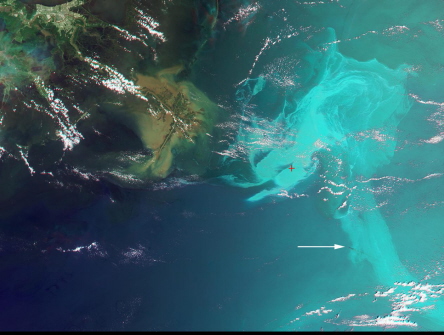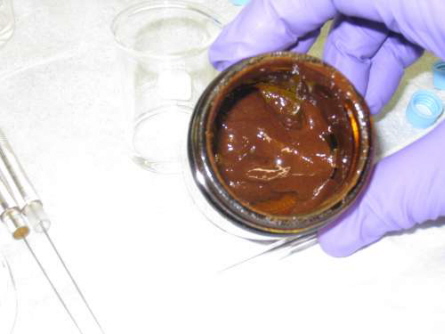The oily Gulf
The Gulf oil spill is massive, will take years to clean up.
On the night of April 20, an explosion rocked the Deepwater Horizon. The Deepwater Horizon was a huge building or platform in the middle of the Gulf of Mexico used to drill oil from deep below the ocean floor. Most of the 126 people on the platform escaped, but 11 people died and others were injured. Rescue workers raced to the scene to put out the fire, but deep underwater another situation was getting underway — one that has turned into an environmental disaster.
 |
|
This image combines different snapshots taken by instruments aboard the NASA Terra satellite May 17. The arrow points to what is probably a plume of smoke from attempts to burn the oil from the surface. The oil appears cyan blue. The Mississippi River Del
|
| NASA, GSFC, LaRC, JPL, MISR Team |
Oil began leaking from the “riser pipe,” which connected the platform to the well on the ocean floor, 5,000 feet below. Like a giant straw, the pipe carried oil from the ocean floor up to the platform. When the rig sank to the ocean floor on April 22, the riser pipe became disconnected — and crumpled. Since then, oil has been spewing out into the water.
In an interview in May, Carol Browner said, “This is probably the biggest environmental disaster we have ever faced in this country.” Browner is assistant to the President for energy and climate change policy.
As the spewed oil, or oil slick, spreads, it pollutes the water, endangers wildlife and threatens a way of life for people who live near the Gulf Coast. In May, the National Oceanic and Atmospheric Administration declared 25 percent of the U.S. portion of the Gulf closed to fishing. The declaration aims to keep people from eating contaminated fish.
By late May, oil-drenched animals, including Louisiana’s state bird, the brown pelican, were showing up near the shoreline. Beaches and swampy areas near the shore had become splashed with oil. The oil could continue to wash ashore for weeks — or even months — and the environmental damage may take years to clean up.
 |
|
The U.S. Geological Survey is analyzing the oil. Pictured is a sample collected by Louisiana USGS scientists Greg Swayze and Charles Demas.
|
| Photo by Leslie C. Gordon/USGS |
It’s been difficult to estimate how much oil has leaked, and how far the oil slick will spread. Initial reports by British Petroleum (BP), the oil company that was leasing the Deepwater Horizon, and by the U.S. Coast Guard estimated a leak of 1,000 to 5,000 barrels per day. (A barrel is 42 gallons.) At a rate of 5,000 barrels per day, the leak would fill an Olympic-size swimming pool in three days.
But even those estimates were too low, according to Steve Wereley, a mechanical engineer from Purdue University. Wereley and a team of engineers studied a 30-second video clip of the leak, released by BP, and were able to estimate from those videos and other information how much oil is escaping from the ruptured pipe. In May, the team reported its findings to a committee in the U.S. Congress.
Wereley’s team paid careful attention to the size and shape of the plume in the video clip. (The plume is the blast of oil coming out of damaged parts of the riser pipe.) By measuring and analyzing the plume in the video clip, the engineers estimated the rate of the spill to be somewhere between 76,000 and 109,000 barrels of oil per day. In addition to presenting his own study, Wereley testified that four other independent studies had arrived at estimates ranging from 25,000 to 100,000 barrels per day.
He said that all the other estimates “are considerably higher than BP’s.” The studies may not all agree with each other, but they all agree that initial reports were too low. The disaster has become the worst oil spill in history, even worse than when the Exxon Valdez spilled 11 million gallons of oil into Alaskan waters in 1989.
Emergency workers have used many different approaches to try to clean up the spill. A small amount of the oil that has reached the surface of the Gulf has been burned off. BP tried to install giant domes over the leaks to catch the escaping oil. As of late May, these attempts had all failed, and the oil continues to pour into Gulf waters. BP has also used dispersants, chemicals that can break the oil apart, to try to slow down the damage.
But to fully stop the leaks and block the oil could take weeks, if not months. And natural phenomena might make the problem worse: Natural currents that move water through the Gulf help spread the slick, and scientists worry that hurricanes — which usually strike between June and October — could carry the oil to inland wetlands. Clean-up will take years.
All in all, the oil spill is a tragic situation in a part of the country still recovering from the devastation of Hurricane Katrina in 2005. It may take years to fully understand the extent of the damage.
POWER WORDS (from Yahoo! Kids Dictionary and oilgasglossary.com)
plume A space in air, water or soil containing pollutants released from a specific, point source.
barrel Any of various units of volume or capacity. In the U.S. Customary System it varies, as a liquid measure, from 31 to 42 gallons (120 to 159 liters) as established by law or usage.
dispersant A liquid or gas added to a mixture to promote dispersion (separation and spreading out) or to maintain dispersed particles in suspension.
offshore drilling Drilling for oil or gas from the floor of an ocean, gulf, or sea, usually on the outer continental shelf. A drilling unit for offshore operations may be a mobile floating vessel with a ship or barge hull, a semisubmersible or submersible base, a self-propelled or towed structure with jacking legs, or a permanent structure used as a production platform when drilling is completed.
Going Deeper:
aloff, Janet. 2010. “BP’s estimate of spill rate is way low, engineer suggests,” Science News, May 19. http://www.sciencenews.org/view/generic/id/59381/title/BP%E2%80%99s_estimate_of_spill_rate_is_way_low%2C_engineer_suggests
Keep track of the efforts to clean up the oil spill: www.deepwaterhorizonresponse.com
See NASA photos of the oil spill: http://www.nasa.gov/topics/earth/features/oilspill/index.html
Raloff, Janet. 2010. “Preventing disastrous offshore spills may require space-program diligence,” Science News, May 4. http://www.sciencenews.org/view/generic/id/58855/title/Preventing_disastrous_offshore_spills_may_require_space-program_diligence







